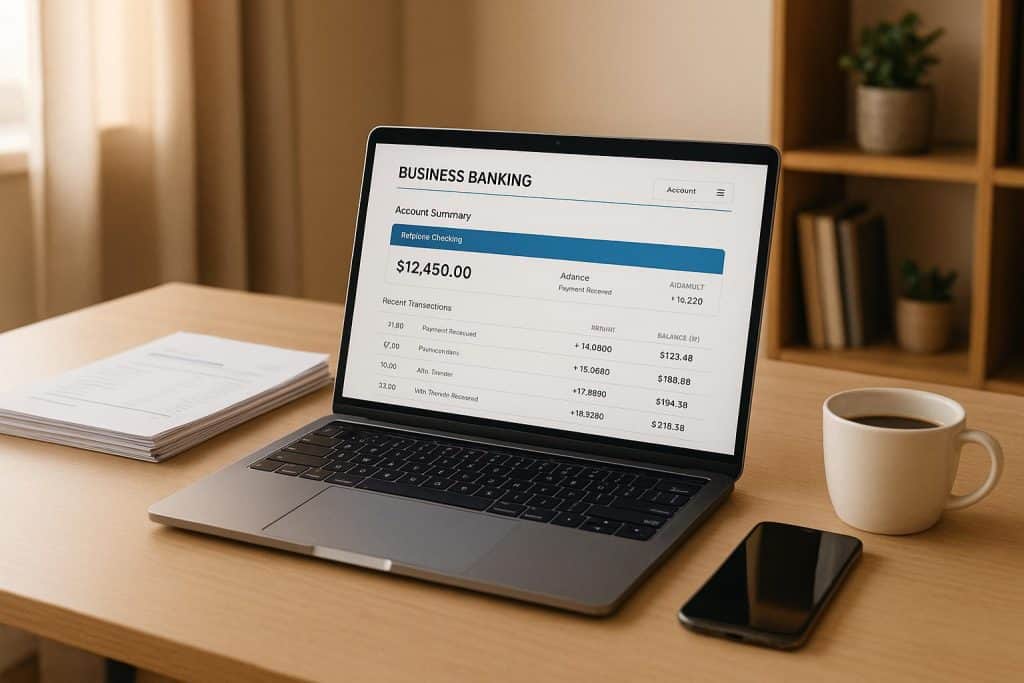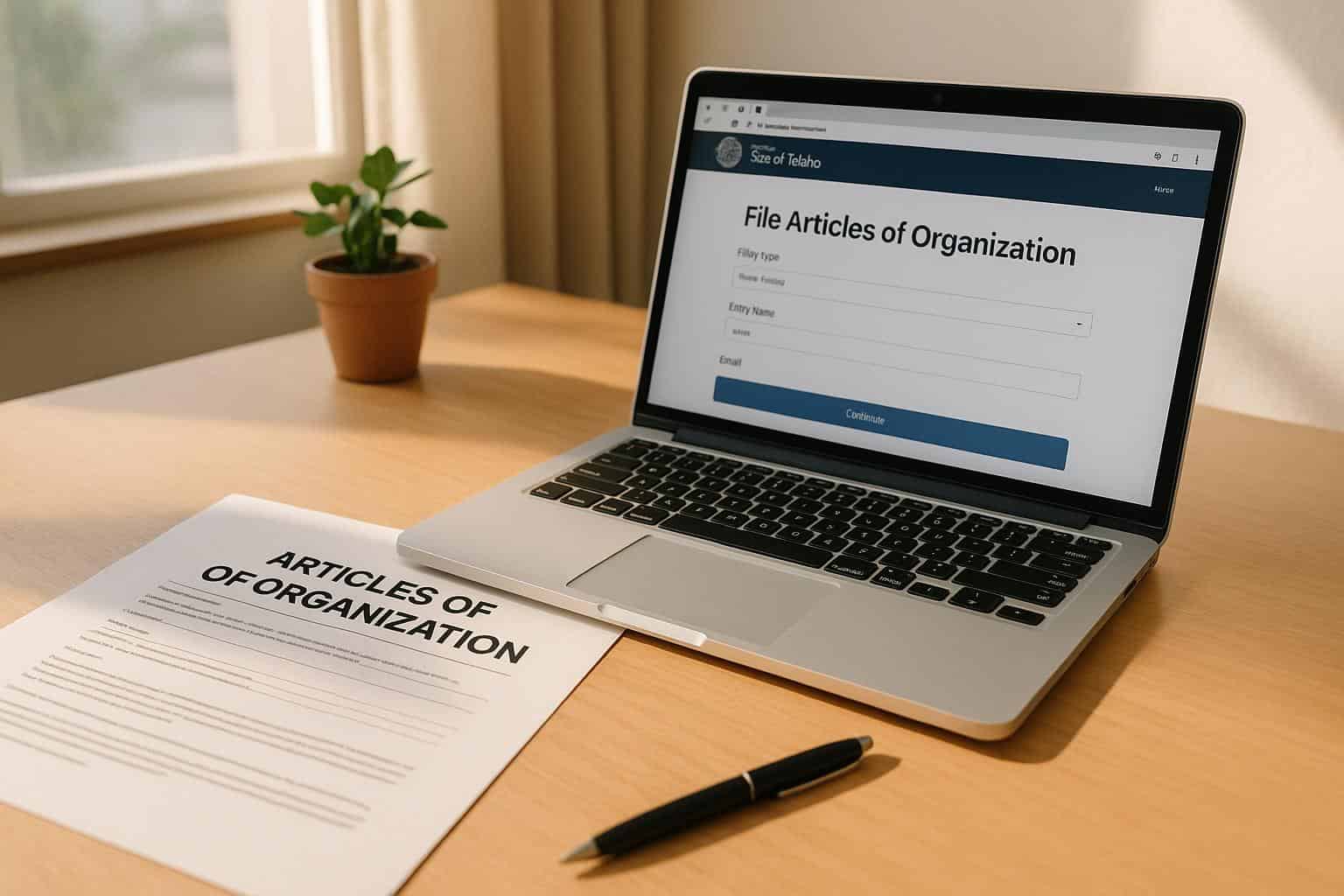Opening a business bank account online is easier than you think. Here’s how to do it in just 5 steps:
- Prepare Your Documents: Gather your Articles of Organization, EIN, business licenses, ID, and proof of address.
- Choose the Right Bank: Compare fees, transaction limits, and integration with accounting tools.
- Submit Your Application: Fill out the bank’s online form with your business details.
- Complete Verification: Provide identification and business documents to confirm your credentials.
- Set Up Your Account: Make your first deposit, enable security features, and connect to financial tools.
Quick Overview of Bank Types:
| Feature | Online Banks ($0–$15 fees) | Traditional Banks ($15–$50+ fees) |
|---|---|---|
| Cash Deposits | Limited | Available |
| Interest Rates | Higher | Lower |
| Customer Support | Digital-only | In-person & digital |
Start by organizing your documents and comparing banks to find the best fit for your business needs.
Step 1: Prepare Required Documents
To make your online application process smoother, have these key documents ready.
Business Registration Documents
You’ll need to provide paperwork that confirms your business is legally established and compliant with state regulations:
- Articles of Organization or Incorporation: Filed with your state’s Secretary of State, this proves your business’s legal formation.
- Employer Identification Number (EIN): Your business’s tax ID issued by the IRS.
- Business License: Any state, local, or industry-specific permits your business requires.
- Operating Agreement: For LLCs, this outlines ownership and management details.
- Corporate Bylaws: For corporations, these specify company rules and procedures.
- DBA Certificate: Necessary if your business operates under a name different from its legal name.
- Certificate of Good Standing: Confirms your business meets state compliance requirements.
Owner Identification Documents
Banks require identity verification for any owner holding 25% or more of the business:
- Government-issued Photo ID: A valid driver’s license, passport, or state ID card.
- Social Security Number: Used for identity verification.
- Proof of Address: A recent utility bill or lease agreement, typically dated within the last 90 days.
- Personal Bank Statements: Usually for the past three months.
- Business Address Verification: A lease agreement or property deed for physical locations.
Quick Tip: Scan all your documents into high-quality PDFs, ensuring they’re clear and under 10MB each for easy submission.
Keeping your business documents organized is crucial. Platforms like Business Anywhere can simplify this by securely storing your company formation documents, making them easily accessible for banking and other needs.
Once you’ve gathered these documents, you’re ready to move on to Step 2: Choosing the right bank.
Step 2: Select Your Bank
Once you’ve gathered your documents from Step 1, the next step is choosing a bank that aligns with your business needs.
What to Look for in a Bank
Finding the right bank means evaluating its fees, tools, and features to ensure they suit your business operations.
Key Factors to Consider:
- Fee Structure
Monthly fees can range from $0 to $50. Online banks usually charge less, between $0 and $15, and many banks offer fee waivers if you maintain a minimum balance or meet specific transaction thresholds. - Transaction Limits and Costs
Most banks include a set number of free monthly transactions (100–500). Beyond that, extra transactions typically cost $0.25–$0.50 each. Wire transfers range from $15 to $50 domestically and $35 to $75 internationally. Cash deposit limits often fall between $5,000 and $10,000 per month. - Digital Banking Tools
Look for features like mobile check deposit, ACH transfers, bill payment, multi-user access with customizable permissions, real-time alerts, and fraud protection. - Software Integration
Ensure the bank integrates with tools you already use, such as:- Accounting software (e.g., QuickBooks, Xero, FreshBooks)
- Payment processors (e.g., Square, Stripe, PayPal)
- Point-of-sale systems
- Expense management platforms
Online vs. Traditional Banks
Your choice between an online-only bank and a traditional bank depends on the specific needs of your business. Here’s a quick comparison:
| Feature | Online-Only Banks | Traditional Banks |
|---|---|---|
| Monthly Fees | Lower ($0–$15) | Higher ($15–$50+) |
| Interest Rates | Higher | Lower |
| Cash Deposits | Limited options | Available at branches |
| ATM Network | Partner networks | Own network + partners |
| Customer Support | Digital-only | In-person and digital |
| Account Opening | Fully online | Online or in-branch |
| Integration | Often more advanced | Varies by bank |
Additionally, prioritize banks with strong security measures, such as multi-factor authentication and real-time fraud monitoring, to safeguard your business finances.
Step 3: Submit Your Application
Once you’ve chosen your bank, it’s time to fill out the online application. Make sure you have all your documents handy before starting. You’ll need to provide your business registration details, including your exact legal business name and Employer Identification Number (EIN). Keep in mind that specific requirements may differ depending on the bank and the nature of your business.
Step 4: Complete Verification Steps
After submitting your application, the bank will begin verifying your details. This process ensures your identity and business credentials are legitimate, helping to prevent fraud and meet federal regulations.
Owner Background Checks
To confirm your identity, the bank will require government-issued identification. You’ll also need to prove that you’re authorized to open the account on behalf of your business. This step is crucial to establish your role and ensure everything is in order.
In addition, the bank will review your business’s legal documents to verify its legitimacy.
Business Status Verification
To confirm your business’s status, be prepared to provide:
- Your EIN (Employer Identification Number)
- Formation documents
- Necessary licenses
Keeping these documents updated and easily accessible in digital format can speed up the verification process significantly.
sbb-itb-ba0a4be
Step 5: Set Up Your Account
Once your account is approved, there are a few steps you’ll need to follow to get everything up and running smoothly.
First Deposit Methods
Start by making your initial deposit. The table below outlines some common methods, their processing times, and typical limits. Keep in mind that minimum deposit requirements may vary depending on your bank.
| Deposit Method | Processing Time | Typical Limits |
|---|---|---|
| ACH Transfer | 1–3 business days | Up to $25,000 |
| Wire Transfer | Same day | $1,000+ |
| Mobile Check Deposit | 1–5 business days | Varies by bank |
| Cash Deposit (Branch/ATM) | Immediate | Based on account type |
Once your account is funded, take proactive steps to secure it.
Account Security Setup
To protect your account and its data, enable these key security features:
- Two-Factor Authentication (2FA): Add an extra layer of protection by requiring a verification code for every login attempt.
- Account Alerts: Configure notifications for large transactions, international transfers, or logins from new devices.
- User Access Management: If multiple users will access the account, create individual logins and assign permissions based on their roles.
Integration Setup
Connect your account to essential tools like accounting software, payment processors, and automated bill payment systems. This will streamline your financial management and save time.
For a centralized way to oversee your business finances, consider using platforms like Business Anywhere, which allows you to manage everything from one dashboard.
Lastly, keep digital copies of important documents, such as your account agreement, deposit confirmation, and verification emails, as well as securely store user credentials for easy access when needed.
Conclusion: Next Steps
You’ve successfully opened your business bank account online – now it’s time to make the most of it. While the verification process (which typically takes 2-5 business days) is underway, use this period to plan your next moves.
Once your account is verified, integrate it into your financial workflow. Start by connecting it to accounting software to simplify tasks like expense tracking, tax preparation, and reconciliation. This will help establish a solid financial system from the start.
Take immediate steps to secure your account:
- Enable fraud monitoring and set up account alerts to stay informed of any unusual activity.
- Grant multi-user access with role-based permissions to control who can access sensitive features.
- Schedule regular reconciliation checks to ensure your records match your bank statements.
- Document your banking procedures so your team has clear guidelines to follow.
Your new account can also help you build business credit and unlock additional financial tools. Many banks offer services such as merchant accounts, business credit cards, and cash management solutions designed to support your company’s growth.
For easier management, consider using Business Anywhere. This platform helps you stay compliant and keeps all your business records organized in one convenient dashboard.
FAQs
What are the main differences between online-only banks and traditional banks for business accounts?
Online-Only Banks vs. Traditional Banks for Business Accounts
When it comes to business accounts, online-only banks and traditional banks each bring distinct advantages to the table. Here’s how they compare:
- Accessibility: Online-only banks operate exclusively through digital platforms, giving you 24/7 access to your account from anywhere with an internet connection. In contrast, traditional banks offer physical branches, where you can get face-to-face assistance when needed.
- Fees and Costs: Online-only banks often keep fees low – or eliminate them altogether – since they don’t have to cover the expenses of maintaining physical locations. On the flip side, traditional banks may charge higher fees but often provide a broader range of services.
- Features and Services: Online banks excel in offering streamlined digital tools, such as mobile check deposits and integrations with accounting software. Meanwhile, traditional banks typically provide additional services like loans, cash deposits, and one-on-one financial guidance.
Choosing between the two depends on what your business values most – whether that’s the convenience of advanced digital tools or the personalized support available at a local branch.
What steps can I take to keep my business bank account secure after setting it up online?
How to Keep Your Business Bank Account Secure
Once you’ve set up your business bank account online, it’s crucial to take steps to protect it. Here are some practical tips to keep your account safe:
- Choose strong, unique passwords: Use a mix of uppercase and lowercase letters, numbers, and special characters. Skip anything predictable like birthdays or common phrases.
- Turn on two-factor authentication (2FA): Many banks offer 2FA, which adds an extra layer of protection by requiring a second step, like entering a code sent to your phone.
- Check account activity often: Make it a habit to review your account for any unusual transactions. Most banks offer real-time alerts to notify you of changes or potential issues.
- Avoid public Wi-Fi for banking: Stick to secure, private internet connections when accessing your account. Public Wi-Fi can leave you vulnerable to hackers.
- Update your software regularly: Keep your devices and banking apps up to date with the latest security patches. This helps close off any potential weak spots.
Taking these precautions can go a long way in keeping your business finances safe from unauthorized access or breaches.
What factors should I consider when selecting a bank that works seamlessly with my business’s financial tools?
When selecting a bank for your business, make sure it works seamlessly with the financial tools you rely on. For example, check if the bank supports integration with accounting software like QuickBooks or payroll systems. These connections can simplify your day-to-day operations and reduce manual work.
Also, explore the bank’s online banking features. Tools like automatic transaction syncing, customizable financial reports, and API access can make managing your business finances much more efficient.
Don’t overlook customer support and account flexibility either. A bank that offers responsive assistance and account options designed to fit your specific business needs can make a big difference. Spending time to research these aspects now can save you a lot of hassle later.







